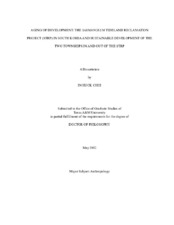| dc.contributor.advisor | Werner, Cynthia | |
| dc.creator | Choi, In Huck | |
| dc.date.accessioned | 2012-07-16T15:58:27Z | |
| dc.date.accessioned | 2012-07-16T20:31:17Z | |
| dc.date.available | 2014-09-16T07:28:21Z | |
| dc.date.created | 2012-05 | |
| dc.date.issued | 2012-07-16 | |
| dc.date.submitted | May 2012 | |
| dc.identifier.uri | https://hdl.handle.net/1969.1/ETD-TAMU-2012-05-11059 | |
| dc.description.abstract | Is the biggest tideland reclamation project in the world (the STRP) sustainable? Since 1991, the STRP which aims at converting mudflats into 401 km2 farmland and industrial complex has been carried out in the southwestern coast of South Korea. I designed a comparative study between two neighboring rural townships with nearly identical social and ecological features except that one is within the project area and no longer has mudflats, and the other is outside of the project area and has retained its mudflats (an important source of clams). This dissertation answers the question above by comparing, sustainable development indicators and quality of life indicators in the two townships. I expected to find that people living in the township within the project area would be more sustainable because they have gone through with the environment versus development controversy in their own villages and many of them participated in person in protests with the national/local environmental movement organizations.
This study uses one of the best known consumption-based sustainable development indicators (SDIs) - Personal Ecological Footprint (PEF), combined with the ethnographic data from the two townships (Gyehwa-township and Simwon-township) – to demonstrate that the PEF values of the two townships appear to be the same and the status of quality of life is quite similar.
As an explanation of the unexpected result, this study contends that the level of sustainable development of the people in the in-project area (Gyehwa-township) has been more affected by nation-wide economic development trajectory than by a major regional development project (the STRP). The first stage of the STRP - the construction of the dykes - has brought about a significant effect of displacement, which cannot be said to be sustainable. However, the total influence on sustainable development in South Korea by the STRP will be determined by the progress of the second stage - internal development. | en |
| dc.format.mimetype | application/pdf | |
| dc.language.iso | en_US | |
| dc.subject | sustainable development | en |
| dc.subject | tideland reclamation | en |
| dc.subject | development | en |
| dc.subject | ecological footprint | en |
| dc.subject | quality of life | en |
| dc.title | Aging of Development: the Saemangeum Tideland Reclamation Project (STRP) in South Korea and Sustainable Development of the Two Townships in and out of the STRP | en |
| dc.type | Thesis | en |
| thesis.degree.department | Anthropology | en |
| thesis.degree.discipline | Anthropology | en |
| thesis.degree.grantor | Texas A&M University | en |
| thesis.degree.name | Doctor of Philosophy | en |
| thesis.degree.level | Doctoral | en |
| dc.contributor.committeeMember | Dannhaeuser, Norbert | |
| dc.contributor.committeeMember | Stronza, Amanda | |
| dc.contributor.committeeMember | Dickson, D. Bruce | |
| dc.type.genre | thesis | en |
| dc.type.material | text | en |
| local.embargo.terms | 2014-07-16 | |


